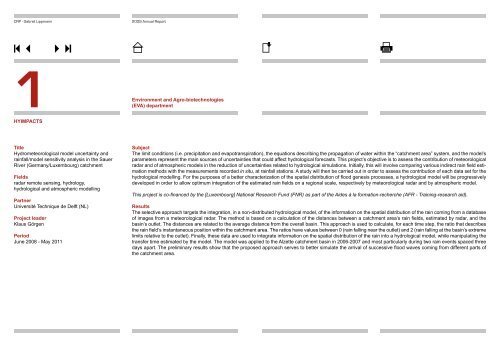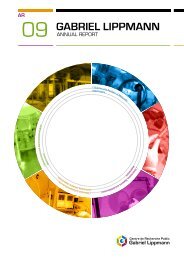1 - Centre de recherche public Gabriel Lippmann
1 - Centre de recherche public Gabriel Lippmann
1 - Centre de recherche public Gabriel Lippmann
You also want an ePaper? Increase the reach of your titles
YUMPU automatically turns print PDFs into web optimized ePapers that Google loves.
CRP - <strong>Gabriel</strong> <strong>Lippmann</strong> 2009 Annual Report<br />
1HYIMPACTS<br />
Title<br />
Hydrometeorological mo<strong>de</strong>l uncertainty and<br />
rainfall/mo<strong>de</strong>l sensitivity analysis in the Sauer<br />
River (Germany/Luxembourg) catchment<br />
Fields<br />
radar remote sensing, hydrology,<br />
hydrological and atmospheric mo<strong>de</strong>lling<br />
Partner<br />
Université Technique <strong>de</strong> Delft (NL)<br />
Project lea<strong>de</strong>r<br />
Klaus Görgen<br />
Period<br />
June 2008 - May 2011<br />
Environment and Agro-biotechnologies<br />
(EVA) <strong>de</strong>partment<br />
Subject<br />
The limit conditions (i.e. precipitation and evapotranspiration), the equations <strong>de</strong>scribing the propagation of water within the “catchment area” system, and the mo<strong>de</strong>l’s<br />
parameters represent the main sources of uncertainties that could affect hydrological forecasts. This project’s objective is to assess the contribution of meteorological<br />
radar and of atmospheric mo<strong>de</strong>ls in the reduction of uncertainties related to hydrological simulations. Initially, this will involve comparing various indirect rain field estimation<br />
methods with the measurements recor<strong>de</strong>d in situ, at rainfall stations. A study will then be carried out in or<strong>de</strong>r to assess the contribution of each data set for the<br />
hydrological mo<strong>de</strong>lling. For the purposes of a better characterization of the spatial distribution of flood genesis processes, a hydrological mo<strong>de</strong>l will be progressively<br />
<strong>de</strong>veloped in or<strong>de</strong>r to allow optimum integration of the estimated rain fields on a regional scale, respectively by meteorological radar and by atmospheric mo<strong>de</strong>l.<br />
This project is co-financed by the [Luxembourg] National Research Fund (FNR) as part of the Ai<strong>de</strong>s à la formation-<strong>recherche</strong> (AFR - Training-research aid).<br />
Results<br />
The selective approach targets the integration, in a non-distributed hydrological mo<strong>de</strong>l, of the information on the spatial distribution of the rain coming from a database<br />
of images from a meteorological radar. The method is based on a calculation of the distances between a catchment area’s rain fields, estimated by radar, and the<br />
basin’s outlet. The distances are related to the average distance from the overall basin. This approach is used to calculate, for each time step, the ratio that <strong>de</strong>scribes<br />
the rain field’s instantaneous position within the catchment area. The ratios have values between 0 (rain falling near the outlet) and 2 (rain falling at the basin’s extreme<br />
limits relative to the outlet). Finally, these data are used to integrate information on the spatial distribution of the rain into a hydrological mo<strong>de</strong>l, while manipulating the<br />
transfer time estimated by the mo<strong>de</strong>l. The mo<strong>de</strong>l was applied to the Alzette catchment basin in 2006-2007 and most particularly during two rain events spaced three<br />
days apart. The preliminary results show that the proposed approach serves to better simulate the arrival of successive flood waves coming from different parts of<br />
the catchment area.



